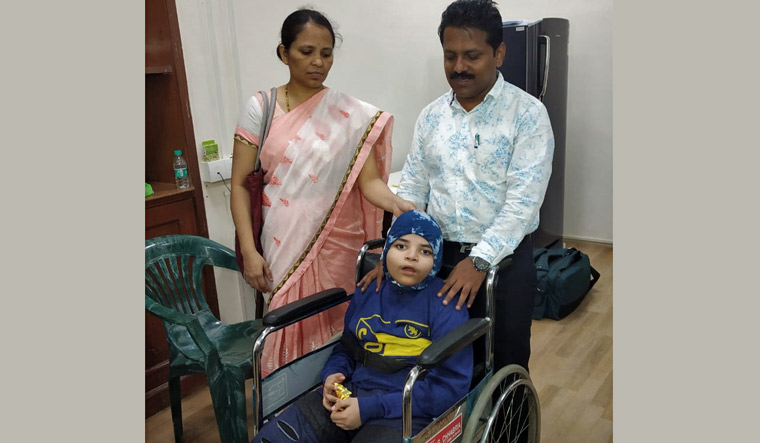
It has only been three months since Krishna Kini, an 11-year-old boy has started taking interest in his surroundings — he now responds to his mother’s calls, expresses joy over anything that catches his fancy and smiles at those who visit him. While other boys his age can run, jump, cycle and swim, Kini cannot even stand on his own feet. He crawls and walks on his knees to explore every thing that he can lay his hands on, inside the family’s two room apartment in Mumbai’s Palghar district. In August 2013 Kini underwent his first brain surgery (Corpus callosotomy, a palliative surgical procedure in which the two halves of the brain are separated by cutting of the corpus callosom to limit the spread of epileptic activity. ) followed by the next one four months later. Krishna suffers from a rare disease, the ‘Lennox-Gastaut Syndrome,’ (LGS) a severe form of epilepsy characterised by recurrent seizures in early childhood. The annual incidence of LGS, is estimated to be 2 per 100,000 children.
“Ever since he was six months old, he has been getting continuous seizures, sometimes up to two hundred in a single day. We would go crazy watching him stiffen up, roll his eyes and sometimes in a fraction of a second, fall down banging his head on the floor,” says his father, Dhiraj Kini. Krishna’s mother Surekha has taken care never to leave him alone and followed him like a shadow all these years. Until now, that is.
On May 30th, a team of doctors from the neurological department of Bai Jerbai Wadia Hospital for Children (BJWHC) in Parel used The Vagal Nerve Stimulator Technique to successfully treat Kini’s LGS syndrome so that the number of seizures would come down drastically from 250 a day to about 5-10 in a day. Dr. Shilpa Kulkarni, Consultant Neurologist at the hospital says, “Krishna was born normally, but due to low blood sugar he suffered multiple seizures in his new-born period which leads to permanent brain damage. At six months he was detected with West Syndrome, a seizure disorder (epilepsy) which gradually evolved into Lennox Gastaut Syndrome, a devastating epilepsy syndrome. He became very weak and infirm due to multiple seizures, was unable to walk and sometimes fell down resulting in major injuries. His quality of life had deteriorated and parents avoided social company to be with him at all times for the fear of falls.”
Krishna had taken multiple anti-epileptic drugs but it didn’t help. Later, he was put on the ketogenic diet — a special diet for epileptic patients — which too, proved ineffective in controlling the seizures. The surgeries he underwent didn’t help improve his condition. It was then, that a team of doctors including Dr. Kulkarni, Dr Chandrashekhar Deopujari, Dr. Milind Sankhe and Dr. Anaita Hegde decided to try the “Vagal Nerve Stimulation (VNS) Therapy, a device that sends mild pulses to the Vagus nerve at regular intervals throughout the day in an effort to prevent seizures. The afferent vagus nerve fibres are thought to increase blood flow and metabolism in regions of the brain associated with onset of epileptic seizures. Luckily, this therapy helped in reductions in seizure severity, duration of seizures, improvement in mental functioning, mood and behaviour,” explains Dr. Kulkarni.
“We are very happy with the improvement we see in Krishna now. His mother no longer has to be with him 24 hours because now he remains alert to his surroundings. He responds to questions and points out to things that excite him. After VNS therapy, in the first month itself the seizures reduced, and his alertness improved. Now the seizures are occasional and he can move around without falling down, which is such a big relief,” exclaims Krishna’s father Dhiraj Kini.
https://www.theweek.in/leisure/society/2018/12/16/nerve-stimulator-helps-11-year-old-fight-rare-form-of-epilepsy.html



